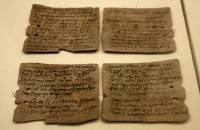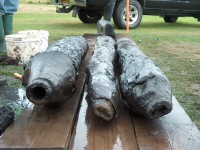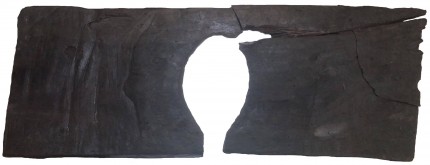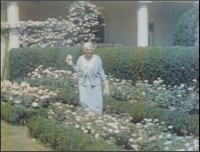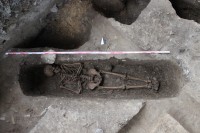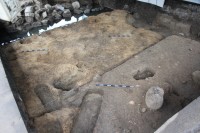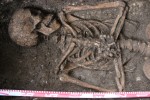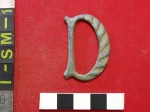 The iconic Vespa that supported the supple fundaments of Audrey Hepburn and Gregory Peck as they scootered their way through the Eternal City in the 1953 classic film Roman Holiday is currently for sale at the online auction site Catawiki. As if co-starring with two of the all-time greatest movie stars in one of the all-time greatest movies weren’t enough, this particular Vespa is also the oldest in the world. With a chassis number of 1003, the Vespa 98cc Serie 0 Numero 3 was the third Vespa ever made. Numbers one and two are long lost, leaving number three with the title of the oldest Vespa.
The iconic Vespa that supported the supple fundaments of Audrey Hepburn and Gregory Peck as they scootered their way through the Eternal City in the 1953 classic film Roman Holiday is currently for sale at the online auction site Catawiki. As if co-starring with two of the all-time greatest movie stars in one of the all-time greatest movies weren’t enough, this particular Vespa is also the oldest in the world. With a chassis number of 1003, the Vespa 98cc Serie 0 Numero 3 was the third Vespa ever made. Numbers one and two are long lost, leaving number three with the title of the oldest Vespa.
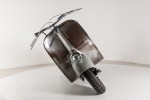 Piaggio began in the late 19th century as a manufacturer of railroad cars. Towards the end of World War I, the company switched its focus to aeronautics but continued to manufacture a wide array of vehicles and parts suitable for civilian and military use. When its main factory was destroyed by Allied bombs in 1940, Piaggio’s production was severely curtailed. After the war, Enrico Piaggio, son of company founder Rinaldo, wanted to produce a low-cost, easy to drive vehicle that could be a reliable mode of transportation for the population of a country whose economy and infrastructure were in ruins.
Piaggio began in the late 19th century as a manufacturer of railroad cars. Towards the end of World War I, the company switched its focus to aeronautics but continued to manufacture a wide array of vehicles and parts suitable for civilian and military use. When its main factory was destroyed by Allied bombs in 1940, Piaggio’s production was severely curtailed. After the war, Enrico Piaggio, son of company founder Rinaldo, wanted to produce a low-cost, easy to drive vehicle that could be a reliable mode of transportation for the population of a country whose economy and infrastructure were in ruins.
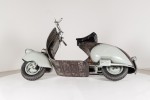 He asked Corradino D’Ascanio, an aeronautical engineer who had worked for Piaggio building airplanes during the war, to scare up a design for a small motorcycle that had none of complications and bulk of its big brothers, making it suitable for wide popular use. Corradino threw out all previous designs and in a matter of days created an entirely new one. His innovations included a gear shift on the handlebars to make driving easier, tires that could be replaced by anyone without need of a mechanic, a body design that protected riders from mud, dust, water and assorted street debris, an enclosed engine that saved street clothes from the scourge of grease stains, and a driving position that allowed riders to be comfortably seated even for long journeys.
He asked Corradino D’Ascanio, an aeronautical engineer who had worked for Piaggio building airplanes during the war, to scare up a design for a small motorcycle that had none of complications and bulk of its big brothers, making it suitable for wide popular use. Corradino threw out all previous designs and in a matter of days created an entirely new one. His innovations included a gear shift on the handlebars to make driving easier, tires that could be replaced by anyone without need of a mechanic, a body design that protected riders from mud, dust, water and assorted street debris, an enclosed engine that saved street clothes from the scourge of grease stains, and a driving position that allowed riders to be comfortably seated even for long journeys.
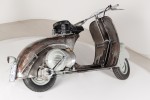 When presented with the prototype in April of 1946, Enrico Piaggio exclaimed delightedly, “It looks like a wasp!” And that’s how the Vespa got its name. In the first decade of manufacture, the Vespa went from a production of 2,000 of the first V98cc models to one million in 1956. In 1965, 3.5 million Vespas were sold, one for every 52 Italians. Today it remains one of the great successes in motor vehicle history, and the original Vespa is an icon of Italian design. There’s a 1955 model in the Museum of Modern Art in New York City. The indelible images of Audrey Hepburn and Gregory Peck zooming through Rome on that Numero 3 certainly played a large part in making the Vespa a worldwide icon.
When presented with the prototype in April of 1946, Enrico Piaggio exclaimed delightedly, “It looks like a wasp!” And that’s how the Vespa got its name. In the first decade of manufacture, the Vespa went from a production of 2,000 of the first V98cc models to one million in 1956. In 1965, 3.5 million Vespas were sold, one for every 52 Italians. Today it remains one of the great successes in motor vehicle history, and the original Vespa is an icon of Italian design. There’s a 1955 model in the Museum of Modern Art in New York City. The indelible images of Audrey Hepburn and Gregory Peck zooming through Rome on that Numero 3 certainly played a large part in making the Vespa a worldwide icon.
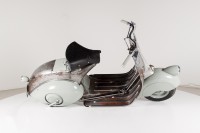 The Serie 0 were prototypes, a sort of run-through of different options, not production units, which is why they are also known as the “pre-series.” Only 60 of the series were manufactured. Every part of the Serie 0 Vespas was individually made specifically for one bike. You can see the chassis number 1003 stamped not just on the frame, but on the fenders, muffler, kickstand and many other parts. This vehicle was lovingly handcrafted piece by piece. It’s also tough as nails. The paint is gone, but 71 years after it was made, Number 3 is still in working condition.
The Serie 0 were prototypes, a sort of run-through of different options, not production units, which is why they are also known as the “pre-series.” Only 60 of the series were manufactured. Every part of the Serie 0 Vespas was individually made specifically for one bike. You can see the chassis number 1003 stamped not just on the frame, but on the fenders, muffler, kickstand and many other parts. This vehicle was lovingly handcrafted piece by piece. It’s also tough as nails. The paint is gone, but 71 years after it was made, Number 3 is still in working condition.
As is the case with some cars, Vespa scooters have become increasingly valuable over time.
“Thanks to a huge fan base, old Vespa scooters tend to keep their monetary value,” said [Vespa expert Davide] Marelli.
“A Vespa scooter from the 1970s, for example, can be worth five times as much as its original retail price. The older the Vespa, the more valuable it is,” he said.
For many years it has belonged to a private collector who has a prestigious, very select group of 60 rare and important Vespas. The presale estimate is 250,000-300,000 euros ($268,150-$348,600). Bidding is already up to $195,748 and there are still 36 hours to go before the sale closes. A small price to pay for the chance to own a piece of history and to touch butts with Audrey Hepburn and Gregory Peck via the Transitive Postulate.






